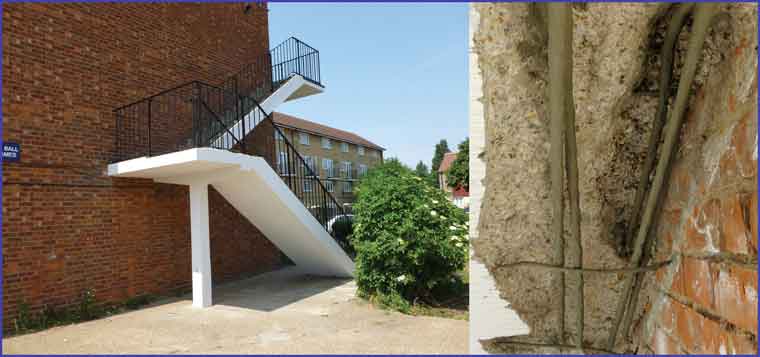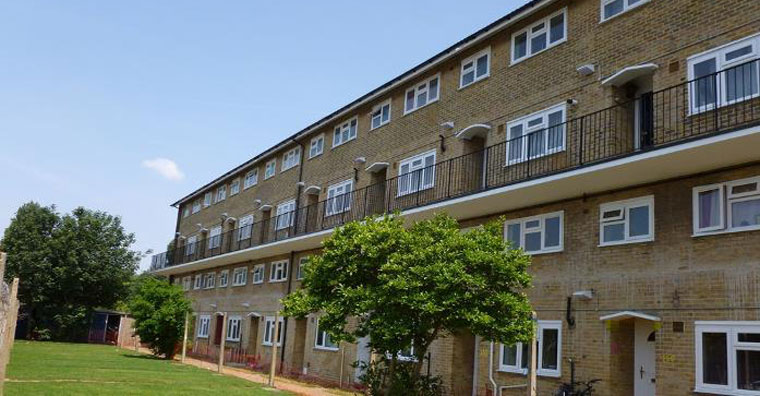Graham James highlights how high performance anti-carbonation coatings can help local authorities extend the lifespan of their housing stock.
Masonry Paints
When local authorities are looking to protect and enhance the outside appearance of housing accommodation, there is a multitude of products available for the refurbishment of external walls, from inexpensive masonry paints to high performance, anti-carbonation wall coatings that can be assured to last at least 10-15 years.
In almost all cases, the cheapest solution is not the most cost-effective long-term. What may appear to be an attractive option could prove to be a very expensive mistake, especially on high-rise accommodation blocks. Repainting may become necessary within months and the cost of hiring access equipment and mobilisation can amount to a significant proportion of the whole contract value.
An inexpensive masonry paint may well appear to transform the appearance of a building short-term, but water ingress, carbonation and mould growth all have damaging effects and can make structures look very unsightly very quickly. Carbonation is without question one of the most common forms of deterioration of concrete buildings, whereby carbon dioxide from the atmosphere reacts with the concrete, leading to a loss of alkalinity and subsequent corrosion of the reinforcing steel.
All reinforced concrete structures are affected by carbonation virtually from the day they are built, so need protection in order to avoid expensive repair and maintenance work down the line. Pigmented anti-carbonation coatings will redecorate a tired façade, but anti-carbonation coating technology is also available as a transparent finish to preserve the original appearance of the building.
Another key factor to consider when selecting a suitable product is that walls need to breathe. Rain saturated walls rely on wind action to dry them out and sunshine also helps, but this can be in short supply, especially in the winter months. If walls cannot breathe, then moisture vapour builds up behind the coating, leading to blistering or flaking in the paint or coating, especially under freeze/thaw conditions. A damp substrate is also an ideal breeding ground for unsightly algae and mould growth.
Developments in Anti-Carbonation Coatings
Manufacturers offer a range of weatherproof, anti-carbonation coatings, which provide ultimate protection against carbonation, atmospheric chemicals and water ingress, whilst allowing damp substrates to breathe without blistering. Such products include the Monodex range of coatings, which have water-based, low hazard, high build formulations and are ultra-fast drying, enabling two coat applications on the same day even in UK weather conditions.
They incorporate an active in-film fungicide, which inhibits the growth of mould, fungi and lichens and with an elastomeric formulation, are able to cover static cracks and bridge dynamic cracks. Able to withstand extreme temperatures of -50°C to +80°C without deterioration, the coatings also remain unaffected by exposure to direct sunlight. With a lifespan of up to 15 years, the coatings can considerably extend the life expectancy of new and existing buildings.
The latest addition to the range is Monodex Textured, a water-based, single component, acrylic wall coating with a textured finish and anti-microbial protection. Due to its composition, it is ideal for hiding surface defects and imperfections, providing walls with a uniform appearance and improving the aesthetic appeal of buildings.
It can be applied to any exterior wall substrate — whether this is concrete, brick, stone, render, pebbledash or over sound existing paints. One distinct advantage is that it will cover over fine cracks, unlike standard paints, which are unlikely to hide such unsightly defects. Unusually for this type of high relief coating, it has an elastomeric formulation, which facilitates substrate movement without cracking or flaking.
The solution, in addition to a range of other repair and protection materials, has been used by Gunite (Eastern) for a project at Jeremy’s Green on the outskirts of Edmonton, North London for the London Borough of Enfield. Jeremy’s Green is a residential housing complex containing 176 flats, apartments and maisonettes in blocks of two and three storeys.
Jeremy’s Green
The oldest properties were built in the 1950s and the concrete soffits and balconies had previously been protected with a coating that had badly deteriorated over time. An effective repair solution was first required to reinstate the fabric of the structure before the application of a coating to provide an aesthetic finish, whilst protecting the structure from further degradation.
The Flexcrete products specified provided a complete system for repairing the defects, which are typical on structures of this type, as well as enhancing the appearance with high performance protective coatings. At Jeremy’s Green, in order to keep disruption, noise and debris to a minimum, it was a special requirement that the selected fairing coat could effectively bond to the existing coated concrete to level out imperfections in the crazed surfaces.
Areas requiring concrete repair were treated with Flexcrete Steel Reinforcement Protector 841 and missing or removed concrete was repaired with Monomix — an advanced, single component, low density, shrinkage compensated, waterproof concrete repair mortar, which is easily applied by trowel to thicknesses of up to 80mm in a single application.
A fine grade cementitious fairing coat, Monolevel 250F, was then used to level out the soffits of the balconies and provide an even surface before re-coating could be carried out.The fairing coat was developed specifically for this type of application as it can be applied directly to existing sound painted surfaces where crazing is evident on the paint or coating.
It demonstrates excellent substrate adhesion and no primers are needed; it simply requires the addition of water on-site to provide an adhesive repair mortar, which can be rapidly applied by bag-rubbing, trowel or spatula. It can be applied up to 4mm in a single layer and can be feather edged.
Bond-Prime was used to seal the substrate before the application of protective coatings. The Monodex Textured was applied as the first coat and then Monodex Smooth as the top coat to achieve the desired finish. The system helped transform the appearance of the balconies and soffits and will provide waterproof and anti-carbonation protection for at least 15 years.




